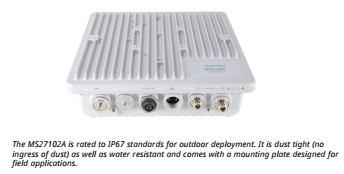The perfect tool for government regulators
Spectrum Monitoring
The MS27102A is part of a spectrum monitoring system used to identify and measure spectrum usage and to locate and remove illegal or unlicensed interference signals. This is key in keeping critical communication channels such as transport, broadcasting, public safety and utilities free of impediments and distortion. Regulating the use of radio transmissions and mitigating interference in the spectrum has become a high priority with government regulators.
Spectrum Occupancy
Spectrum monitoring is also used to characterize spectrum occupancy. Government regulators and operators are often interested in determining the usage rate for various frequency bands. Monitoring these frequencies provides the information needed to optimize spectrum for maximum utilization. Spectrum can be re-purposed for other applications or multiplexed with other signals using cognitive radio techniques.

Features
• Sweep rates up to 24 GHz/s
• Low spurious signals for accurate signal discovery
• 20 MHz IF bandwidth
• Low power consumption < 11 watts
• Integrated GPS receiver for monitoring location and time synchronization applications
• Gigabit Ethernet available for high speed communications
• Measurements: occupied bandwidth and channel power
• Interference analysis: spectrogram and signal strength
• Dynamic range: > 106 dB normalized to 1 Hz BW
• Phase noise: –99 dBc/Hz @ 10 kHz offset at 1 GHz
• Frequency accuracy: < ±1.5 ppm, < ±50 ppb with GPS High Accuracy Mode
• IQ block mode and streaming with time stamping for time difference of arrival (TDOA) applications
• Remote control via SCPI commands
• VisionTM software optional for automated spectrum measurements, setting alarms, and geo-locating signal sources
• SpectraVisionTM software options for signal quality analysis
• Standard 3-year warranty

Communicating with Remote Spectrum Monitors
Integrated Web Server
Using an internet browser (Chrome and FireFox are supported), a user from anywhere in the world can log in to the spectrum monitor and control any of its features. This includes such parameters as frequency setting, RBW/VBW control, reference level configuration and many other settings relevant to the user’s spectrum monitoring application. At the same time, trace data, spectrograms and other measurements can be viewed inside the browser window.
SCPI Programming
Users can also write their own monitoring program using available SCPI commands. Anritsu provides a user manual listing each SCPI command, a description of the commands and the correct syntax required for each command. Additionally, each individual pair of IQ data output by the monitors is time-stamped using high precision GPS signals. This enables the use of IQ data for Time Difference of Arrival (TDOA) applications for geo-locating signal positions.
VisionTM Application Software
Vision works with the monitoring hardware to automate the process of collecting measurement data, providing useful information about network heath and use of the spectrum. Two components of Vision, Vision Monitor and Vision Locate, are responsible for monitoring and locating interference signals. Vision Monitor automatically records spectrum data, maintains a searchable spectrum history database, enables alarm functions for unusual signal activity, automatically sends email alerts and provides a set of tools for managing the spectrum monitoring system. Vision Locate provides the capability to geo-locate interference or illegal/unlicensed signals.
SpectraVisionTM Application Software
For more detailed analysis of satellite signal quality, SpectraVision software is available to demodulate signals using the DVB-S1, DVB-S2 and IESS standards. Parameters such as C/N, MER, EVM and modulation/coding schemes are presented. Alarms can be triggered based on such parameters as EVM or MER when values fall below a certain user-defined threshold.
Key Benefits of Remote Spectrum Monitoring
• Automation and scalability
• Using Vision software or your own applications, users can identify patterns of interference, record a spectrum history and locate the sources of problem signals
• SpectraVision software allows users to perform signal analysis for satellite and other signal types
• New features and options can be added remotely, no site visits required
Key Applications
• Network interference monitoring
• Geo-location of interference signals
• Maintain history of spectrum activity
• Set power threshold levels to automatically generate alarms

